Corporate Takeover Decision Making and the Effects on Consolidation Accounting
VerifiedAdded on 2023/02/01
|11
|3501
|93
AI Summary
The report intends to obtain a critical insight of the different accounting aspects associated with acquisition of a smaller organisation, FAB Limited by JKY Limited. At the time of analysing the differences between consolidation accounting and equity accounting when an organisation acquires a smaller firm, there are different measurement and recognition principles. Moreover, the treatment of intra-group transactions undertakes significant differences in the consolidated financial statements of both organisations. Finally, it has been evaluated that the disclosure requirements requiring non-controlling interest as a separate item in the consolidated financial statements has impact on the overall consolidation process.
Contribute Materials
Your contribution can guide someone’s learning journey. Share your
documents today.
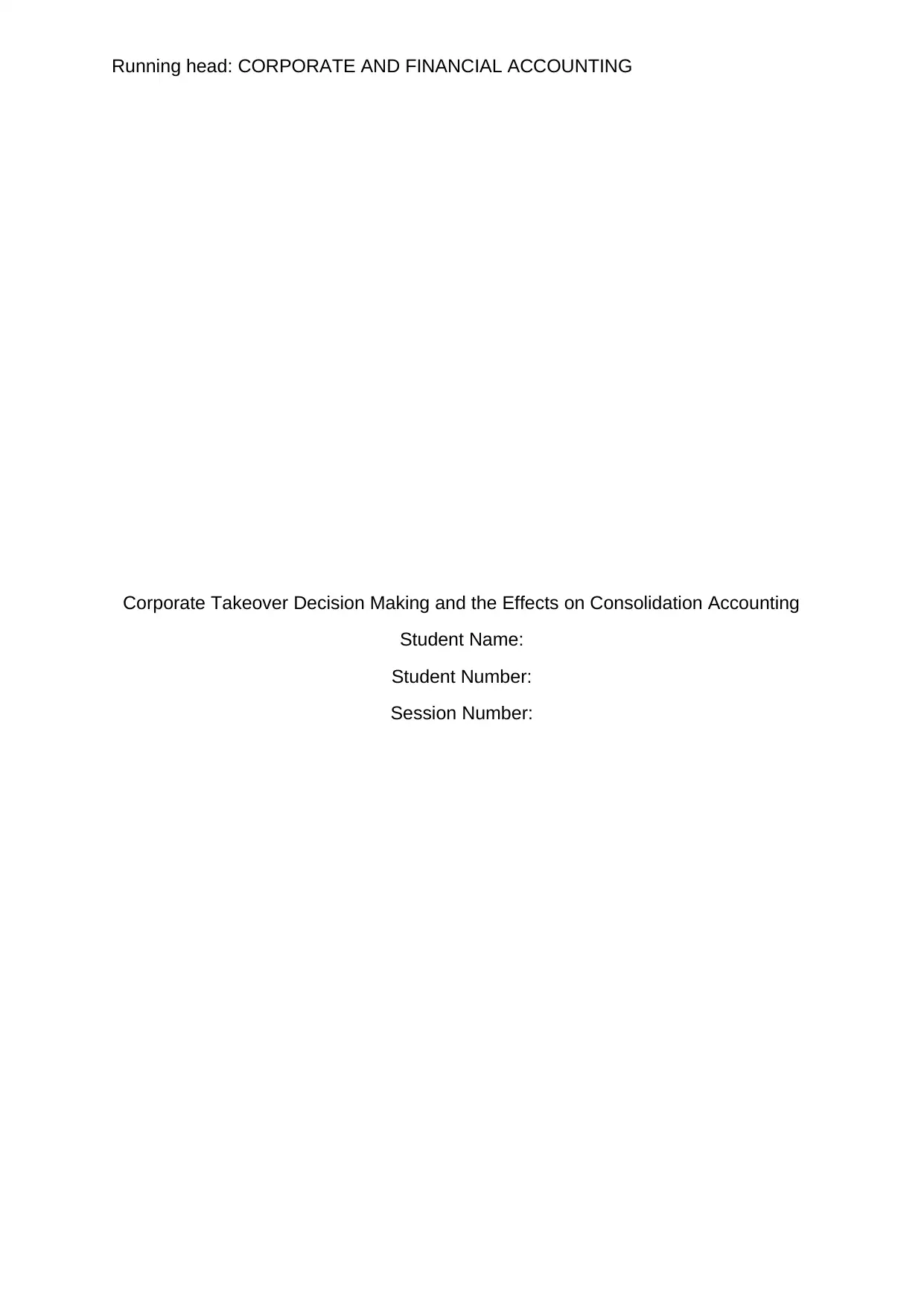
Running head: CORPORATE AND FINANCIAL ACCOUNTING
Corporate Takeover Decision Making and the Effects on Consolidation Accounting
Student Name:
Student Number:
Session Number:
Corporate Takeover Decision Making and the Effects on Consolidation Accounting
Student Name:
Student Number:
Session Number:
Secure Best Marks with AI Grader
Need help grading? Try our AI Grader for instant feedback on your assignments.
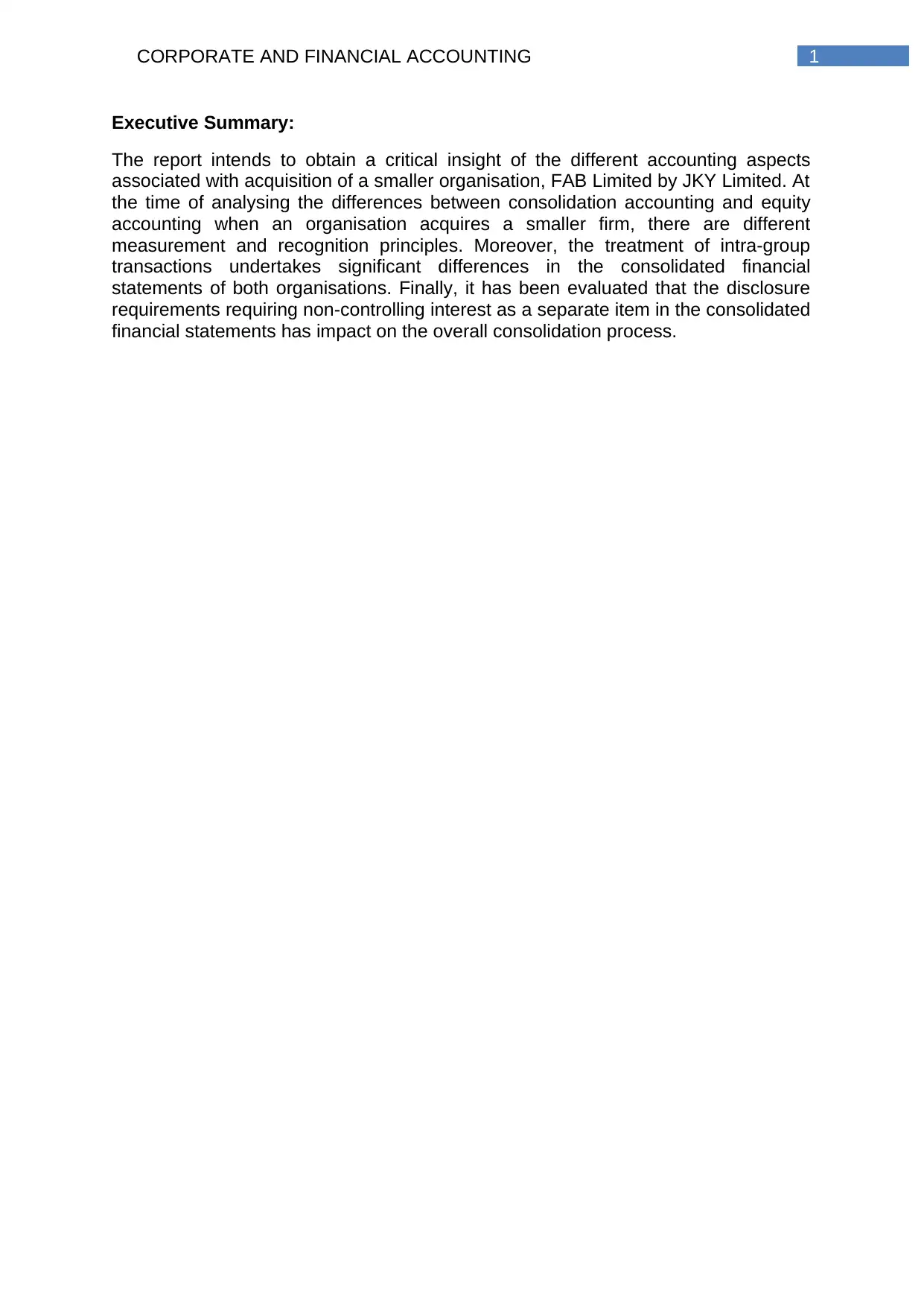
1CORPORATE AND FINANCIAL ACCOUNTING
Executive Summary:
The report intends to obtain a critical insight of the different accounting aspects
associated with acquisition of a smaller organisation, FAB Limited by JKY Limited. At
the time of analysing the differences between consolidation accounting and equity
accounting when an organisation acquires a smaller firm, there are different
measurement and recognition principles. Moreover, the treatment of intra-group
transactions undertakes significant differences in the consolidated financial
statements of both organisations. Finally, it has been evaluated that the disclosure
requirements requiring non-controlling interest as a separate item in the consolidated
financial statements has impact on the overall consolidation process.
Executive Summary:
The report intends to obtain a critical insight of the different accounting aspects
associated with acquisition of a smaller organisation, FAB Limited by JKY Limited. At
the time of analysing the differences between consolidation accounting and equity
accounting when an organisation acquires a smaller firm, there are different
measurement and recognition principles. Moreover, the treatment of intra-group
transactions undertakes significant differences in the consolidated financial
statements of both organisations. Finally, it has been evaluated that the disclosure
requirements requiring non-controlling interest as a separate item in the consolidated
financial statements has impact on the overall consolidation process.

2CORPORATE AND FINANCIAL ACCOUNTING
Table of Contents
Introduction:..................................................................................................................3
Part A Response:..........................................................................................................3
Part B Response:..........................................................................................................5
Part C Response:.........................................................................................................6
Conclusion:...................................................................................................................8
Reference List:..............................................................................................................9
Table of Contents
Introduction:..................................................................................................................3
Part A Response:..........................................................................................................3
Part B Response:..........................................................................................................5
Part C Response:.........................................................................................................6
Conclusion:...................................................................................................................8
Reference List:..............................................................................................................9
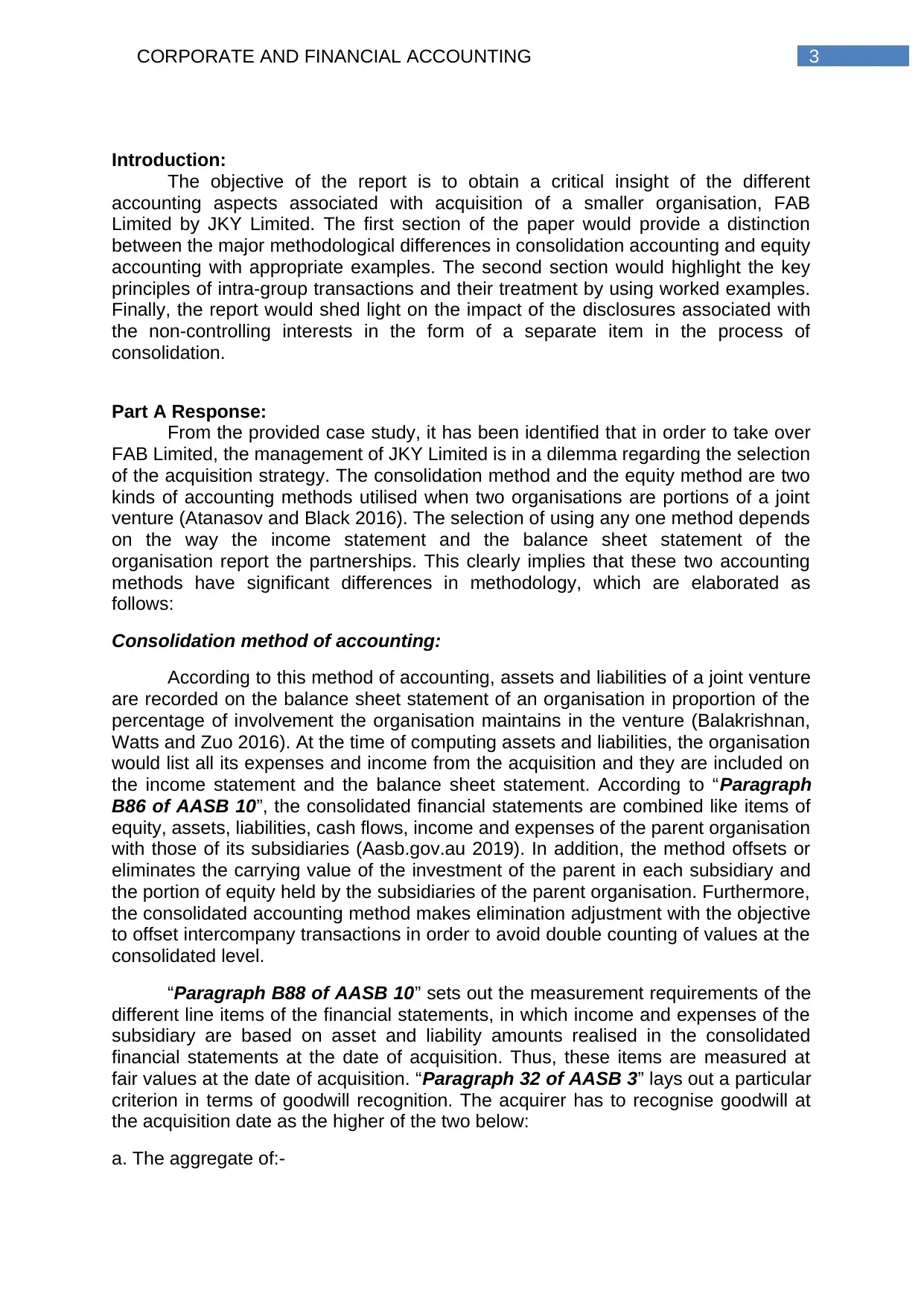
3CORPORATE AND FINANCIAL ACCOUNTING
Introduction:
The objective of the report is to obtain a critical insight of the different
accounting aspects associated with acquisition of a smaller organisation, FAB
Limited by JKY Limited. The first section of the paper would provide a distinction
between the major methodological differences in consolidation accounting and equity
accounting with appropriate examples. The second section would highlight the key
principles of intra-group transactions and their treatment by using worked examples.
Finally, the report would shed light on the impact of the disclosures associated with
the non-controlling interests in the form of a separate item in the process of
consolidation.
Part A Response:
From the provided case study, it has been identified that in order to take over
FAB Limited, the management of JKY Limited is in a dilemma regarding the selection
of the acquisition strategy. The consolidation method and the equity method are two
kinds of accounting methods utilised when two organisations are portions of a joint
venture (Atanasov and Black 2016). The selection of using any one method depends
on the way the income statement and the balance sheet statement of the
organisation report the partnerships. This clearly implies that these two accounting
methods have significant differences in methodology, which are elaborated as
follows:
Consolidation method of accounting:
According to this method of accounting, assets and liabilities of a joint venture
are recorded on the balance sheet statement of an organisation in proportion of the
percentage of involvement the organisation maintains in the venture (Balakrishnan,
Watts and Zuo 2016). At the time of computing assets and liabilities, the organisation
would list all its expenses and income from the acquisition and they are included on
the income statement and the balance sheet statement. According to “Paragraph
B86 of AASB 10”, the consolidated financial statements are combined like items of
equity, assets, liabilities, cash flows, income and expenses of the parent organisation
with those of its subsidiaries (Aasb.gov.au 2019). In addition, the method offsets or
eliminates the carrying value of the investment of the parent in each subsidiary and
the portion of equity held by the subsidiaries of the parent organisation. Furthermore,
the consolidated accounting method makes elimination adjustment with the objective
to offset intercompany transactions in order to avoid double counting of values at the
consolidated level.
“Paragraph B88 of AASB 10” sets out the measurement requirements of the
different line items of the financial statements, in which income and expenses of the
subsidiary are based on asset and liability amounts realised in the consolidated
financial statements at the date of acquisition. Thus, these items are measured at
fair values at the date of acquisition. “Paragraph 32 of AASB 3” lays out a particular
criterion in terms of goodwill recognition. The acquirer has to recognise goodwill at
the acquisition date as the higher of the two below:
a. The aggregate of:-
Introduction:
The objective of the report is to obtain a critical insight of the different
accounting aspects associated with acquisition of a smaller organisation, FAB
Limited by JKY Limited. The first section of the paper would provide a distinction
between the major methodological differences in consolidation accounting and equity
accounting with appropriate examples. The second section would highlight the key
principles of intra-group transactions and their treatment by using worked examples.
Finally, the report would shed light on the impact of the disclosures associated with
the non-controlling interests in the form of a separate item in the process of
consolidation.
Part A Response:
From the provided case study, it has been identified that in order to take over
FAB Limited, the management of JKY Limited is in a dilemma regarding the selection
of the acquisition strategy. The consolidation method and the equity method are two
kinds of accounting methods utilised when two organisations are portions of a joint
venture (Atanasov and Black 2016). The selection of using any one method depends
on the way the income statement and the balance sheet statement of the
organisation report the partnerships. This clearly implies that these two accounting
methods have significant differences in methodology, which are elaborated as
follows:
Consolidation method of accounting:
According to this method of accounting, assets and liabilities of a joint venture
are recorded on the balance sheet statement of an organisation in proportion of the
percentage of involvement the organisation maintains in the venture (Balakrishnan,
Watts and Zuo 2016). At the time of computing assets and liabilities, the organisation
would list all its expenses and income from the acquisition and they are included on
the income statement and the balance sheet statement. According to “Paragraph
B86 of AASB 10”, the consolidated financial statements are combined like items of
equity, assets, liabilities, cash flows, income and expenses of the parent organisation
with those of its subsidiaries (Aasb.gov.au 2019). In addition, the method offsets or
eliminates the carrying value of the investment of the parent in each subsidiary and
the portion of equity held by the subsidiaries of the parent organisation. Furthermore,
the consolidated accounting method makes elimination adjustment with the objective
to offset intercompany transactions in order to avoid double counting of values at the
consolidated level.
“Paragraph B88 of AASB 10” sets out the measurement requirements of the
different line items of the financial statements, in which income and expenses of the
subsidiary are based on asset and liability amounts realised in the consolidated
financial statements at the date of acquisition. Thus, these items are measured at
fair values at the date of acquisition. “Paragraph 32 of AASB 3” lays out a particular
criterion in terms of goodwill recognition. The acquirer has to recognise goodwill at
the acquisition date as the higher of the two below:
a. The aggregate of:-
Secure Best Marks with AI Grader
Need help grading? Try our AI Grader for instant feedback on your assignments.
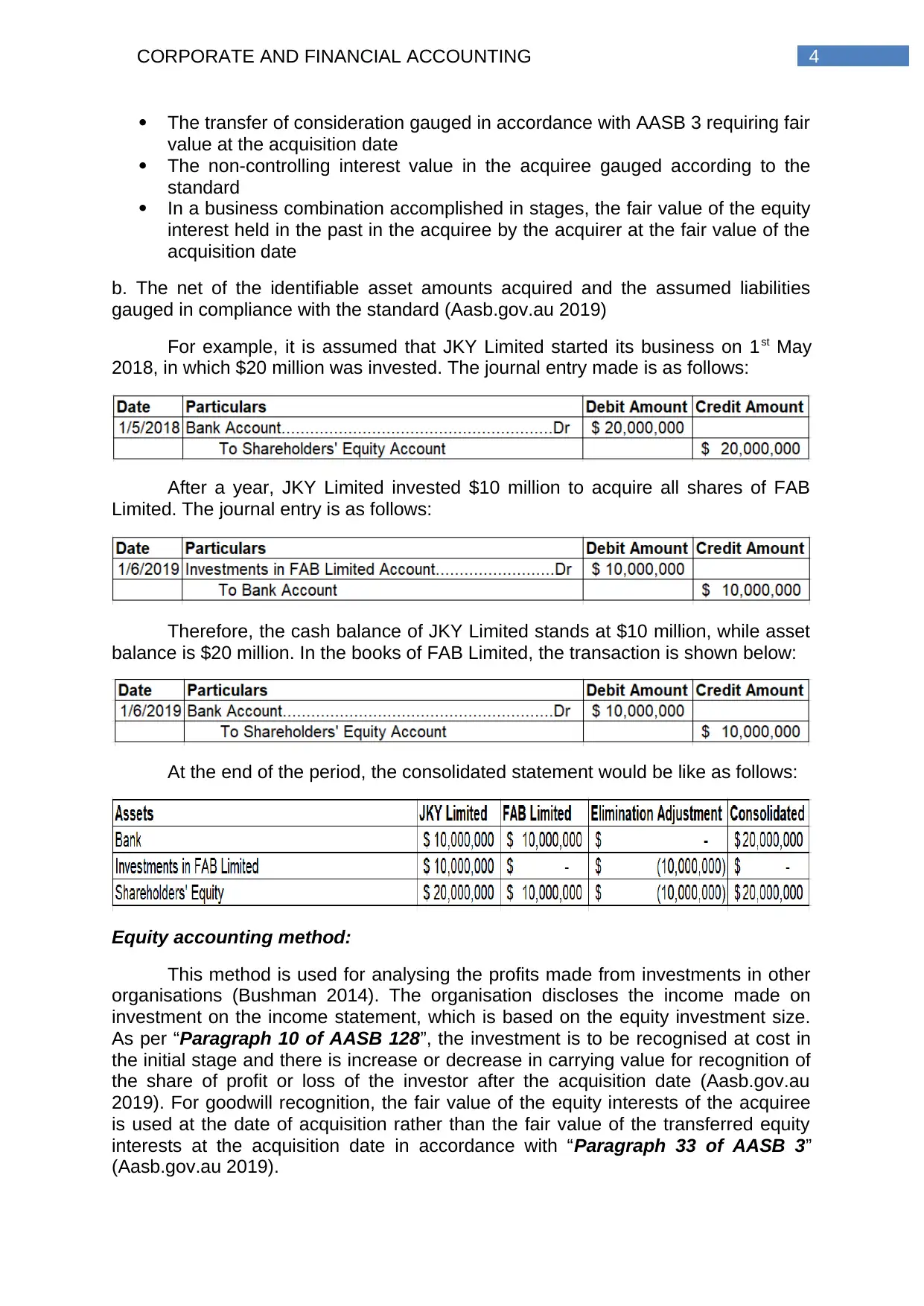
4CORPORATE AND FINANCIAL ACCOUNTING
The transfer of consideration gauged in accordance with AASB 3 requiring fair
value at the acquisition date
The non-controlling interest value in the acquiree gauged according to the
standard
In a business combination accomplished in stages, the fair value of the equity
interest held in the past in the acquiree by the acquirer at the fair value of the
acquisition date
b. The net of the identifiable asset amounts acquired and the assumed liabilities
gauged in compliance with the standard (Aasb.gov.au 2019)
For example, it is assumed that JKY Limited started its business on 1st May
2018, in which $20 million was invested. The journal entry made is as follows:
After a year, JKY Limited invested $10 million to acquire all shares of FAB
Limited. The journal entry is as follows:
Therefore, the cash balance of JKY Limited stands at $10 million, while asset
balance is $20 million. In the books of FAB Limited, the transaction is shown below:
At the end of the period, the consolidated statement would be like as follows:
Equity accounting method:
This method is used for analysing the profits made from investments in other
organisations (Bushman 2014). The organisation discloses the income made on
investment on the income statement, which is based on the equity investment size.
As per “Paragraph 10 of AASB 128”, the investment is to be recognised at cost in
the initial stage and there is increase or decrease in carrying value for recognition of
the share of profit or loss of the investor after the acquisition date (Aasb.gov.au
2019). For goodwill recognition, the fair value of the equity interests of the acquiree
is used at the date of acquisition rather than the fair value of the transferred equity
interests at the acquisition date in accordance with “Paragraph 33 of AASB 3”
(Aasb.gov.au 2019).
The transfer of consideration gauged in accordance with AASB 3 requiring fair
value at the acquisition date
The non-controlling interest value in the acquiree gauged according to the
standard
In a business combination accomplished in stages, the fair value of the equity
interest held in the past in the acquiree by the acquirer at the fair value of the
acquisition date
b. The net of the identifiable asset amounts acquired and the assumed liabilities
gauged in compliance with the standard (Aasb.gov.au 2019)
For example, it is assumed that JKY Limited started its business on 1st May
2018, in which $20 million was invested. The journal entry made is as follows:
After a year, JKY Limited invested $10 million to acquire all shares of FAB
Limited. The journal entry is as follows:
Therefore, the cash balance of JKY Limited stands at $10 million, while asset
balance is $20 million. In the books of FAB Limited, the transaction is shown below:
At the end of the period, the consolidated statement would be like as follows:
Equity accounting method:
This method is used for analysing the profits made from investments in other
organisations (Bushman 2014). The organisation discloses the income made on
investment on the income statement, which is based on the equity investment size.
As per “Paragraph 10 of AASB 128”, the investment is to be recognised at cost in
the initial stage and there is increase or decrease in carrying value for recognition of
the share of profit or loss of the investor after the acquisition date (Aasb.gov.au
2019). For goodwill recognition, the fair value of the equity interests of the acquiree
is used at the date of acquisition rather than the fair value of the transferred equity
interests at the acquisition date in accordance with “Paragraph 33 of AASB 3”
(Aasb.gov.au 2019).
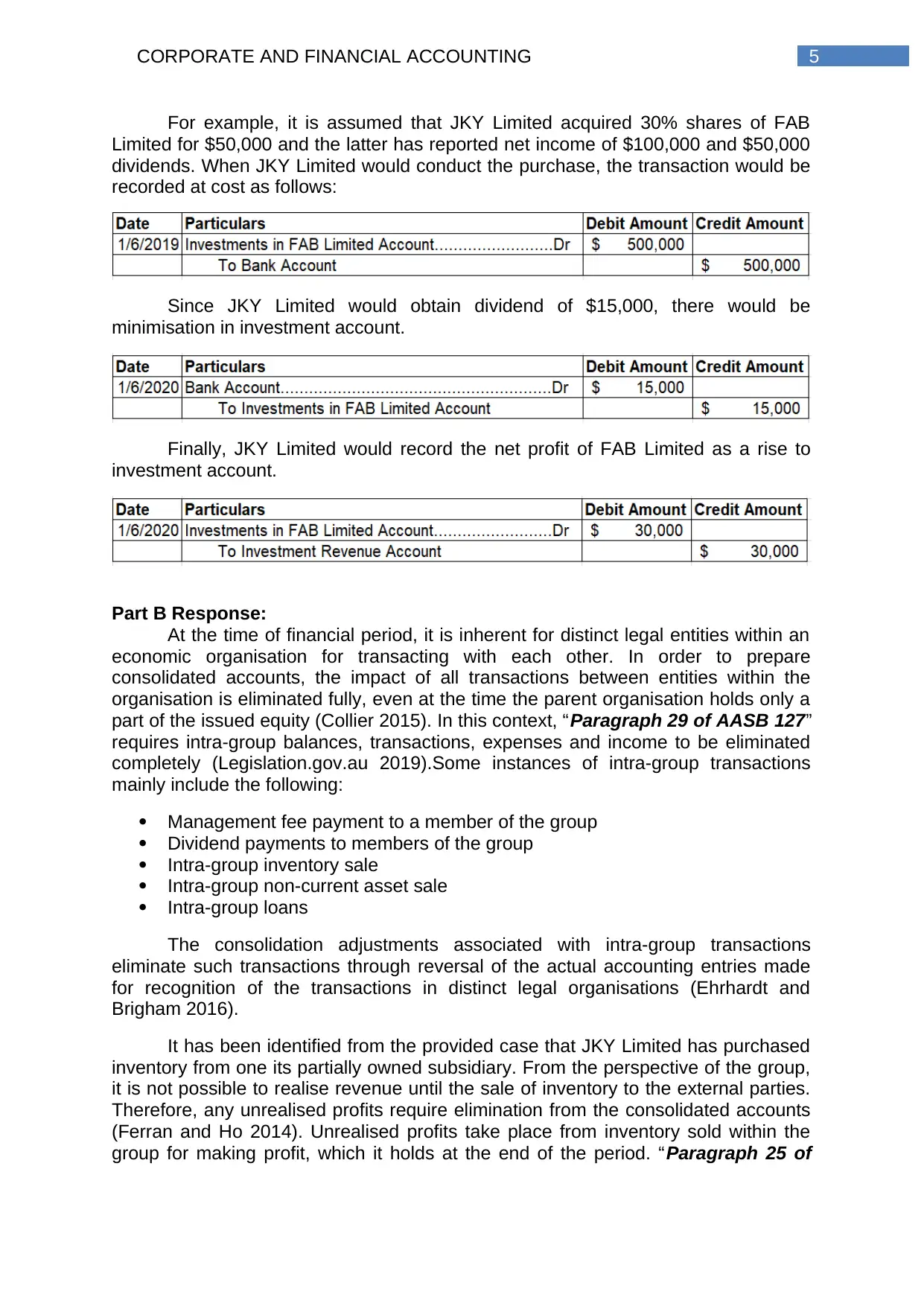
5CORPORATE AND FINANCIAL ACCOUNTING
For example, it is assumed that JKY Limited acquired 30% shares of FAB
Limited for $50,000 and the latter has reported net income of $100,000 and $50,000
dividends. When JKY Limited would conduct the purchase, the transaction would be
recorded at cost as follows:
Since JKY Limited would obtain dividend of $15,000, there would be
minimisation in investment account.
Finally, JKY Limited would record the net profit of FAB Limited as a rise to
investment account.
Part B Response:
At the time of financial period, it is inherent for distinct legal entities within an
economic organisation for transacting with each other. In order to prepare
consolidated accounts, the impact of all transactions between entities within the
organisation is eliminated fully, even at the time the parent organisation holds only a
part of the issued equity (Collier 2015). In this context, “Paragraph 29 of AASB 127”
requires intra-group balances, transactions, expenses and income to be eliminated
completely (Legislation.gov.au 2019).Some instances of intra-group transactions
mainly include the following:
Management fee payment to a member of the group
Dividend payments to members of the group
Intra-group inventory sale
Intra-group non-current asset sale
Intra-group loans
The consolidation adjustments associated with intra-group transactions
eliminate such transactions through reversal of the actual accounting entries made
for recognition of the transactions in distinct legal organisations (Ehrhardt and
Brigham 2016).
It has been identified from the provided case that JKY Limited has purchased
inventory from one its partially owned subsidiary. From the perspective of the group,
it is not possible to realise revenue until the sale of inventory to the external parties.
Therefore, any unrealised profits require elimination from the consolidated accounts
(Ferran and Ho 2014). Unrealised profits take place from inventory sold within the
group for making profit, which it holds at the end of the period. “Paragraph 25 of
For example, it is assumed that JKY Limited acquired 30% shares of FAB
Limited for $50,000 and the latter has reported net income of $100,000 and $50,000
dividends. When JKY Limited would conduct the purchase, the transaction would be
recorded at cost as follows:
Since JKY Limited would obtain dividend of $15,000, there would be
minimisation in investment account.
Finally, JKY Limited would record the net profit of FAB Limited as a rise to
investment account.
Part B Response:
At the time of financial period, it is inherent for distinct legal entities within an
economic organisation for transacting with each other. In order to prepare
consolidated accounts, the impact of all transactions between entities within the
organisation is eliminated fully, even at the time the parent organisation holds only a
part of the issued equity (Collier 2015). In this context, “Paragraph 29 of AASB 127”
requires intra-group balances, transactions, expenses and income to be eliminated
completely (Legislation.gov.au 2019).Some instances of intra-group transactions
mainly include the following:
Management fee payment to a member of the group
Dividend payments to members of the group
Intra-group inventory sale
Intra-group non-current asset sale
Intra-group loans
The consolidation adjustments associated with intra-group transactions
eliminate such transactions through reversal of the actual accounting entries made
for recognition of the transactions in distinct legal organisations (Ehrhardt and
Brigham 2016).
It has been identified from the provided case that JKY Limited has purchased
inventory from one its partially owned subsidiary. From the perspective of the group,
it is not possible to realise revenue until the sale of inventory to the external parties.
Therefore, any unrealised profits require elimination from the consolidated accounts
(Ferran and Ho 2014). Unrealised profits take place from inventory sold within the
group for making profit, which it holds at the end of the period. “Paragraph 25 of
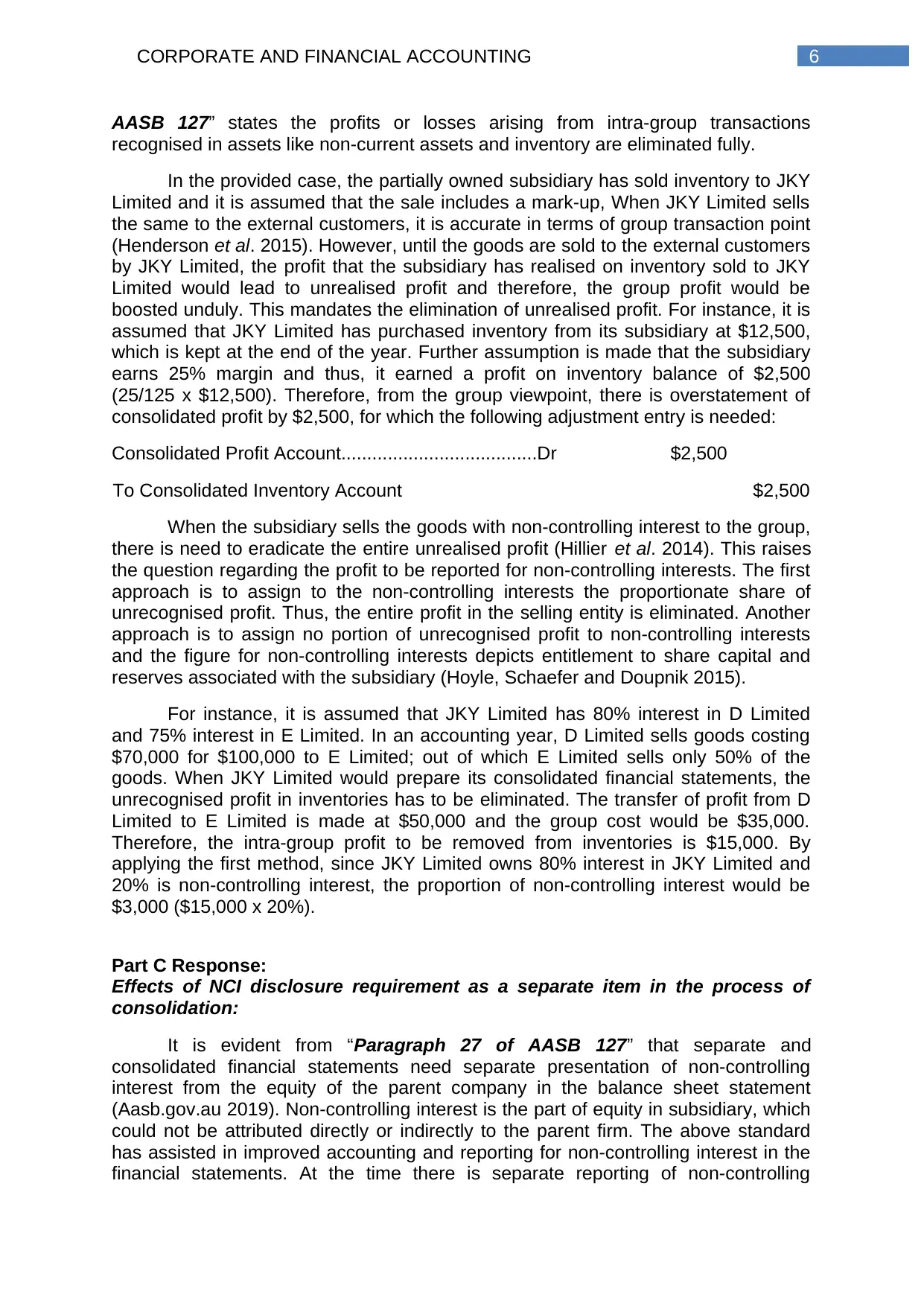
6CORPORATE AND FINANCIAL ACCOUNTING
AASB 127” states the profits or losses arising from intra-group transactions
recognised in assets like non-current assets and inventory are eliminated fully.
In the provided case, the partially owned subsidiary has sold inventory to JKY
Limited and it is assumed that the sale includes a mark-up, When JKY Limited sells
the same to the external customers, it is accurate in terms of group transaction point
(Henderson et al. 2015). However, until the goods are sold to the external customers
by JKY Limited, the profit that the subsidiary has realised on inventory sold to JKY
Limited would lead to unrealised profit and therefore, the group profit would be
boosted unduly. This mandates the elimination of unrealised profit. For instance, it is
assumed that JKY Limited has purchased inventory from its subsidiary at $12,500,
which is kept at the end of the year. Further assumption is made that the subsidiary
earns 25% margin and thus, it earned a profit on inventory balance of $2,500
(25/125 x $12,500). Therefore, from the group viewpoint, there is overstatement of
consolidated profit by $2,500, for which the following adjustment entry is needed:
Consolidated Profit Account......................................Dr $2,500
To Consolidated Inventory Account $2,500
When the subsidiary sells the goods with non-controlling interest to the group,
there is need to eradicate the entire unrealised profit (Hillier et al. 2014). This raises
the question regarding the profit to be reported for non-controlling interests. The first
approach is to assign to the non-controlling interests the proportionate share of
unrecognised profit. Thus, the entire profit in the selling entity is eliminated. Another
approach is to assign no portion of unrecognised profit to non-controlling interests
and the figure for non-controlling interests depicts entitlement to share capital and
reserves associated with the subsidiary (Hoyle, Schaefer and Doupnik 2015).
For instance, it is assumed that JKY Limited has 80% interest in D Limited
and 75% interest in E Limited. In an accounting year, D Limited sells goods costing
$70,000 for $100,000 to E Limited; out of which E Limited sells only 50% of the
goods. When JKY Limited would prepare its consolidated financial statements, the
unrecognised profit in inventories has to be eliminated. The transfer of profit from D
Limited to E Limited is made at $50,000 and the group cost would be $35,000.
Therefore, the intra-group profit to be removed from inventories is $15,000. By
applying the first method, since JKY Limited owns 80% interest in JKY Limited and
20% is non-controlling interest, the proportion of non-controlling interest would be
$3,000 ($15,000 x 20%).
Part C Response:
Effects of NCI disclosure requirement as a separate item in the process of
consolidation:
It is evident from “Paragraph 27 of AASB 127” that separate and
consolidated financial statements need separate presentation of non-controlling
interest from the equity of the parent company in the balance sheet statement
(Aasb.gov.au 2019). Non-controlling interest is the part of equity in subsidiary, which
could not be attributed directly or indirectly to the parent firm. The above standard
has assisted in improved accounting and reporting for non-controlling interest in the
financial statements. At the time there is separate reporting of non-controlling
AASB 127” states the profits or losses arising from intra-group transactions
recognised in assets like non-current assets and inventory are eliminated fully.
In the provided case, the partially owned subsidiary has sold inventory to JKY
Limited and it is assumed that the sale includes a mark-up, When JKY Limited sells
the same to the external customers, it is accurate in terms of group transaction point
(Henderson et al. 2015). However, until the goods are sold to the external customers
by JKY Limited, the profit that the subsidiary has realised on inventory sold to JKY
Limited would lead to unrealised profit and therefore, the group profit would be
boosted unduly. This mandates the elimination of unrealised profit. For instance, it is
assumed that JKY Limited has purchased inventory from its subsidiary at $12,500,
which is kept at the end of the year. Further assumption is made that the subsidiary
earns 25% margin and thus, it earned a profit on inventory balance of $2,500
(25/125 x $12,500). Therefore, from the group viewpoint, there is overstatement of
consolidated profit by $2,500, for which the following adjustment entry is needed:
Consolidated Profit Account......................................Dr $2,500
To Consolidated Inventory Account $2,500
When the subsidiary sells the goods with non-controlling interest to the group,
there is need to eradicate the entire unrealised profit (Hillier et al. 2014). This raises
the question regarding the profit to be reported for non-controlling interests. The first
approach is to assign to the non-controlling interests the proportionate share of
unrecognised profit. Thus, the entire profit in the selling entity is eliminated. Another
approach is to assign no portion of unrecognised profit to non-controlling interests
and the figure for non-controlling interests depicts entitlement to share capital and
reserves associated with the subsidiary (Hoyle, Schaefer and Doupnik 2015).
For instance, it is assumed that JKY Limited has 80% interest in D Limited
and 75% interest in E Limited. In an accounting year, D Limited sells goods costing
$70,000 for $100,000 to E Limited; out of which E Limited sells only 50% of the
goods. When JKY Limited would prepare its consolidated financial statements, the
unrecognised profit in inventories has to be eliminated. The transfer of profit from D
Limited to E Limited is made at $50,000 and the group cost would be $35,000.
Therefore, the intra-group profit to be removed from inventories is $15,000. By
applying the first method, since JKY Limited owns 80% interest in JKY Limited and
20% is non-controlling interest, the proportion of non-controlling interest would be
$3,000 ($15,000 x 20%).
Part C Response:
Effects of NCI disclosure requirement as a separate item in the process of
consolidation:
It is evident from “Paragraph 27 of AASB 127” that separate and
consolidated financial statements need separate presentation of non-controlling
interest from the equity of the parent company in the balance sheet statement
(Aasb.gov.au 2019). Non-controlling interest is the part of equity in subsidiary, which
could not be attributed directly or indirectly to the parent firm. The above standard
has assisted in improved accounting and reporting for non-controlling interest in the
financial statements. At the time there is separate reporting of non-controlling
Paraphrase This Document
Need a fresh take? Get an instant paraphrase of this document with our AI Paraphraser
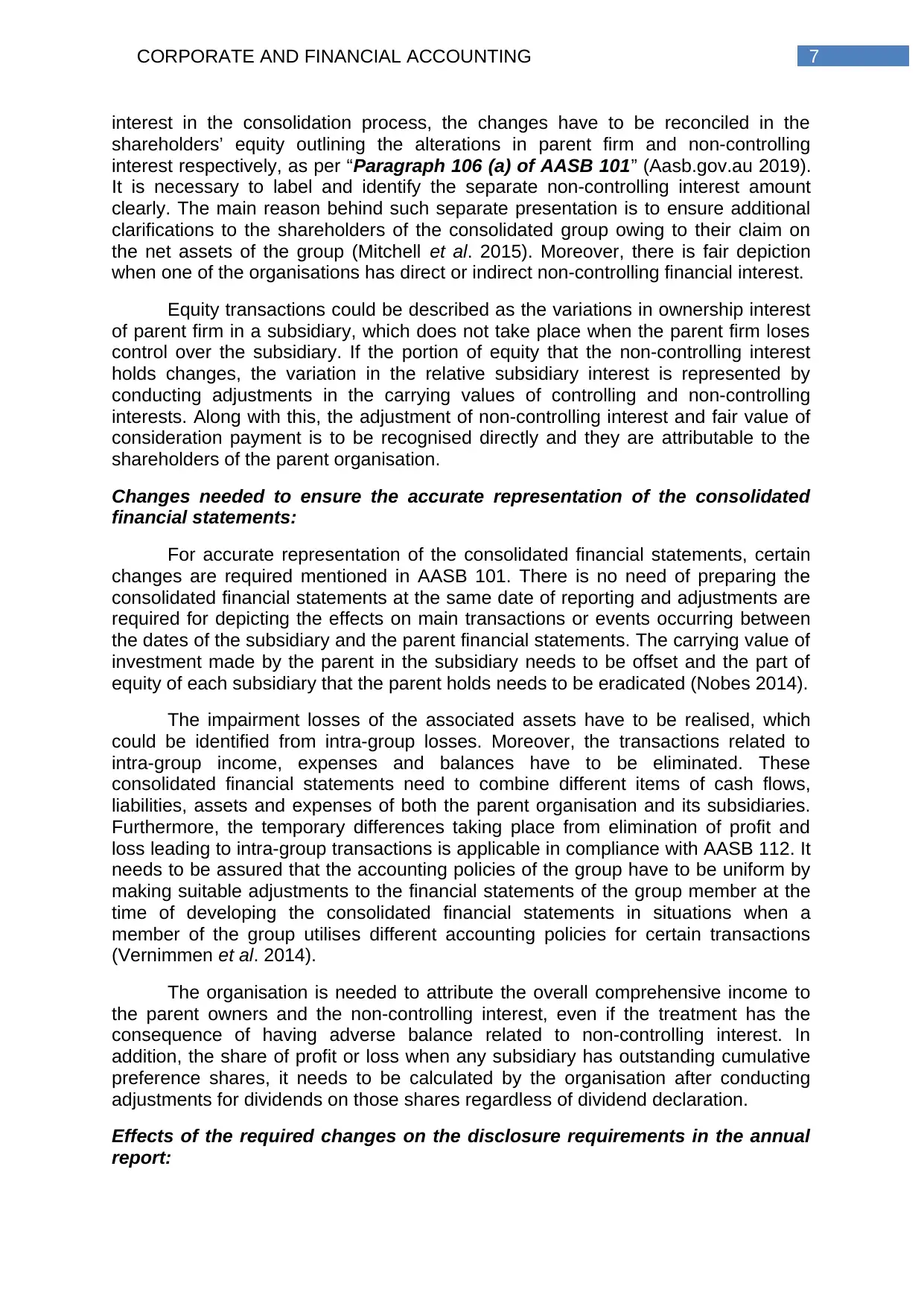
7CORPORATE AND FINANCIAL ACCOUNTING
interest in the consolidation process, the changes have to be reconciled in the
shareholders’ equity outlining the alterations in parent firm and non-controlling
interest respectively, as per “Paragraph 106 (a) of AASB 101” (Aasb.gov.au 2019).
It is necessary to label and identify the separate non-controlling interest amount
clearly. The main reason behind such separate presentation is to ensure additional
clarifications to the shareholders of the consolidated group owing to their claim on
the net assets of the group (Mitchell et al. 2015). Moreover, there is fair depiction
when one of the organisations has direct or indirect non-controlling financial interest.
Equity transactions could be described as the variations in ownership interest
of parent firm in a subsidiary, which does not take place when the parent firm loses
control over the subsidiary. If the portion of equity that the non-controlling interest
holds changes, the variation in the relative subsidiary interest is represented by
conducting adjustments in the carrying values of controlling and non-controlling
interests. Along with this, the adjustment of non-controlling interest and fair value of
consideration payment is to be recognised directly and they are attributable to the
shareholders of the parent organisation.
Changes needed to ensure the accurate representation of the consolidated
financial statements:
For accurate representation of the consolidated financial statements, certain
changes are required mentioned in AASB 101. There is no need of preparing the
consolidated financial statements at the same date of reporting and adjustments are
required for depicting the effects on main transactions or events occurring between
the dates of the subsidiary and the parent financial statements. The carrying value of
investment made by the parent in the subsidiary needs to be offset and the part of
equity of each subsidiary that the parent holds needs to be eradicated (Nobes 2014).
The impairment losses of the associated assets have to be realised, which
could be identified from intra-group losses. Moreover, the transactions related to
intra-group income, expenses and balances have to be eliminated. These
consolidated financial statements need to combine different items of cash flows,
liabilities, assets and expenses of both the parent organisation and its subsidiaries.
Furthermore, the temporary differences taking place from elimination of profit and
loss leading to intra-group transactions is applicable in compliance with AASB 112. It
needs to be assured that the accounting policies of the group have to be uniform by
making suitable adjustments to the financial statements of the group member at the
time of developing the consolidated financial statements in situations when a
member of the group utilises different accounting policies for certain transactions
(Vernimmen et al. 2014).
The organisation is needed to attribute the overall comprehensive income to
the parent owners and the non-controlling interest, even if the treatment has the
consequence of having adverse balance related to non-controlling interest. In
addition, the share of profit or loss when any subsidiary has outstanding cumulative
preference shares, it needs to be calculated by the organisation after conducting
adjustments for dividends on those shares regardless of dividend declaration.
Effects of the required changes on the disclosure requirements in the annual
report:
interest in the consolidation process, the changes have to be reconciled in the
shareholders’ equity outlining the alterations in parent firm and non-controlling
interest respectively, as per “Paragraph 106 (a) of AASB 101” (Aasb.gov.au 2019).
It is necessary to label and identify the separate non-controlling interest amount
clearly. The main reason behind such separate presentation is to ensure additional
clarifications to the shareholders of the consolidated group owing to their claim on
the net assets of the group (Mitchell et al. 2015). Moreover, there is fair depiction
when one of the organisations has direct or indirect non-controlling financial interest.
Equity transactions could be described as the variations in ownership interest
of parent firm in a subsidiary, which does not take place when the parent firm loses
control over the subsidiary. If the portion of equity that the non-controlling interest
holds changes, the variation in the relative subsidiary interest is represented by
conducting adjustments in the carrying values of controlling and non-controlling
interests. Along with this, the adjustment of non-controlling interest and fair value of
consideration payment is to be recognised directly and they are attributable to the
shareholders of the parent organisation.
Changes needed to ensure the accurate representation of the consolidated
financial statements:
For accurate representation of the consolidated financial statements, certain
changes are required mentioned in AASB 101. There is no need of preparing the
consolidated financial statements at the same date of reporting and adjustments are
required for depicting the effects on main transactions or events occurring between
the dates of the subsidiary and the parent financial statements. The carrying value of
investment made by the parent in the subsidiary needs to be offset and the part of
equity of each subsidiary that the parent holds needs to be eradicated (Nobes 2014).
The impairment losses of the associated assets have to be realised, which
could be identified from intra-group losses. Moreover, the transactions related to
intra-group income, expenses and balances have to be eliminated. These
consolidated financial statements need to combine different items of cash flows,
liabilities, assets and expenses of both the parent organisation and its subsidiaries.
Furthermore, the temporary differences taking place from elimination of profit and
loss leading to intra-group transactions is applicable in compliance with AASB 112. It
needs to be assured that the accounting policies of the group have to be uniform by
making suitable adjustments to the financial statements of the group member at the
time of developing the consolidated financial statements in situations when a
member of the group utilises different accounting policies for certain transactions
(Vernimmen et al. 2014).
The organisation is needed to attribute the overall comprehensive income to
the parent owners and the non-controlling interest, even if the treatment has the
consequence of having adverse balance related to non-controlling interest. In
addition, the share of profit or loss when any subsidiary has outstanding cumulative
preference shares, it needs to be calculated by the organisation after conducting
adjustments for dividends on those shares regardless of dividend declaration.
Effects of the required changes on the disclosure requirements in the annual
report:
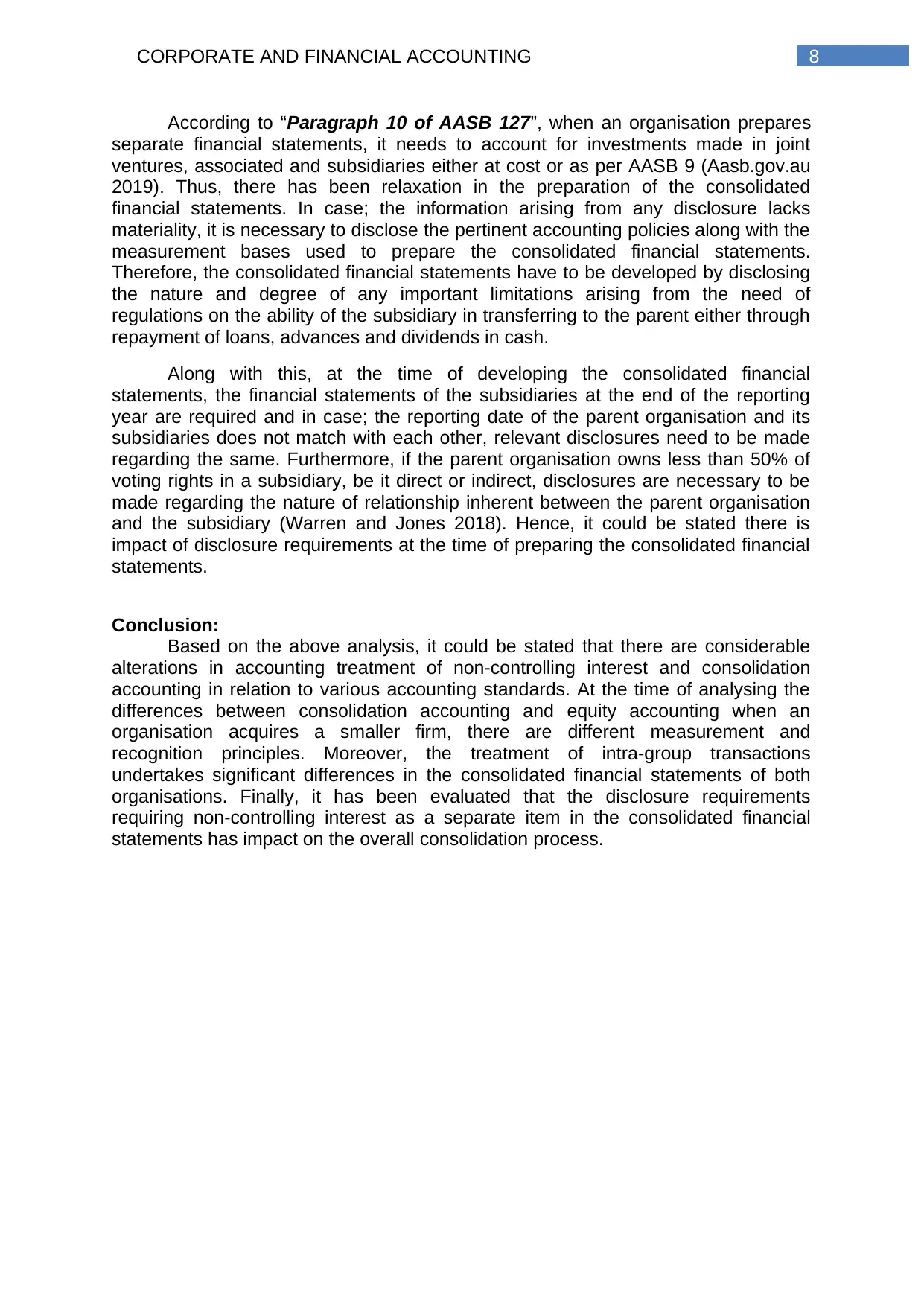
8CORPORATE AND FINANCIAL ACCOUNTING
According to “Paragraph 10 of AASB 127”, when an organisation prepares
separate financial statements, it needs to account for investments made in joint
ventures, associated and subsidiaries either at cost or as per AASB 9 (Aasb.gov.au
2019). Thus, there has been relaxation in the preparation of the consolidated
financial statements. In case; the information arising from any disclosure lacks
materiality, it is necessary to disclose the pertinent accounting policies along with the
measurement bases used to prepare the consolidated financial statements.
Therefore, the consolidated financial statements have to be developed by disclosing
the nature and degree of any important limitations arising from the need of
regulations on the ability of the subsidiary in transferring to the parent either through
repayment of loans, advances and dividends in cash.
Along with this, at the time of developing the consolidated financial
statements, the financial statements of the subsidiaries at the end of the reporting
year are required and in case; the reporting date of the parent organisation and its
subsidiaries does not match with each other, relevant disclosures need to be made
regarding the same. Furthermore, if the parent organisation owns less than 50% of
voting rights in a subsidiary, be it direct or indirect, disclosures are necessary to be
made regarding the nature of relationship inherent between the parent organisation
and the subsidiary (Warren and Jones 2018). Hence, it could be stated there is
impact of disclosure requirements at the time of preparing the consolidated financial
statements.
Conclusion:
Based on the above analysis, it could be stated that there are considerable
alterations in accounting treatment of non-controlling interest and consolidation
accounting in relation to various accounting standards. At the time of analysing the
differences between consolidation accounting and equity accounting when an
organisation acquires a smaller firm, there are different measurement and
recognition principles. Moreover, the treatment of intra-group transactions
undertakes significant differences in the consolidated financial statements of both
organisations. Finally, it has been evaluated that the disclosure requirements
requiring non-controlling interest as a separate item in the consolidated financial
statements has impact on the overall consolidation process.
According to “Paragraph 10 of AASB 127”, when an organisation prepares
separate financial statements, it needs to account for investments made in joint
ventures, associated and subsidiaries either at cost or as per AASB 9 (Aasb.gov.au
2019). Thus, there has been relaxation in the preparation of the consolidated
financial statements. In case; the information arising from any disclosure lacks
materiality, it is necessary to disclose the pertinent accounting policies along with the
measurement bases used to prepare the consolidated financial statements.
Therefore, the consolidated financial statements have to be developed by disclosing
the nature and degree of any important limitations arising from the need of
regulations on the ability of the subsidiary in transferring to the parent either through
repayment of loans, advances and dividends in cash.
Along with this, at the time of developing the consolidated financial
statements, the financial statements of the subsidiaries at the end of the reporting
year are required and in case; the reporting date of the parent organisation and its
subsidiaries does not match with each other, relevant disclosures need to be made
regarding the same. Furthermore, if the parent organisation owns less than 50% of
voting rights in a subsidiary, be it direct or indirect, disclosures are necessary to be
made regarding the nature of relationship inherent between the parent organisation
and the subsidiary (Warren and Jones 2018). Hence, it could be stated there is
impact of disclosure requirements at the time of preparing the consolidated financial
statements.
Conclusion:
Based on the above analysis, it could be stated that there are considerable
alterations in accounting treatment of non-controlling interest and consolidation
accounting in relation to various accounting standards. At the time of analysing the
differences between consolidation accounting and equity accounting when an
organisation acquires a smaller firm, there are different measurement and
recognition principles. Moreover, the treatment of intra-group transactions
undertakes significant differences in the consolidated financial statements of both
organisations. Finally, it has been evaluated that the disclosure requirements
requiring non-controlling interest as a separate item in the consolidated financial
statements has impact on the overall consolidation process.
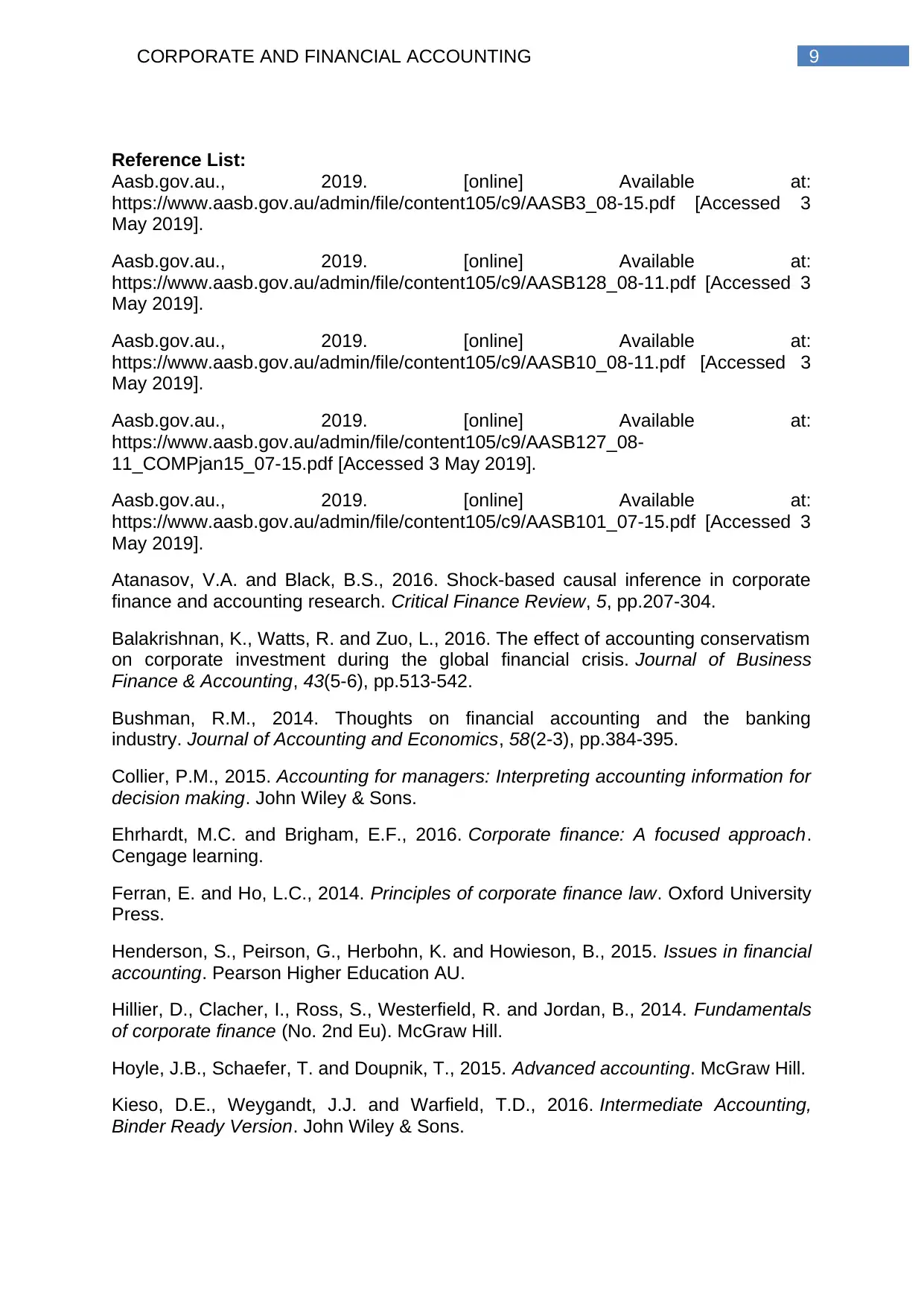
9CORPORATE AND FINANCIAL ACCOUNTING
Reference List:
Aasb.gov.au., 2019. [online] Available at:
https://www.aasb.gov.au/admin/file/content105/c9/AASB3_08-15.pdf [Accessed 3
May 2019].
Aasb.gov.au., 2019. [online] Available at:
https://www.aasb.gov.au/admin/file/content105/c9/AASB128_08-11.pdf [Accessed 3
May 2019].
Aasb.gov.au., 2019. [online] Available at:
https://www.aasb.gov.au/admin/file/content105/c9/AASB10_08-11.pdf [Accessed 3
May 2019].
Aasb.gov.au., 2019. [online] Available at:
https://www.aasb.gov.au/admin/file/content105/c9/AASB127_08-
11_COMPjan15_07-15.pdf [Accessed 3 May 2019].
Aasb.gov.au., 2019. [online] Available at:
https://www.aasb.gov.au/admin/file/content105/c9/AASB101_07-15.pdf [Accessed 3
May 2019].
Atanasov, V.A. and Black, B.S., 2016. Shock-based causal inference in corporate
finance and accounting research. Critical Finance Review, 5, pp.207-304.
Balakrishnan, K., Watts, R. and Zuo, L., 2016. The effect of accounting conservatism
on corporate investment during the global financial crisis. Journal of Business
Finance & Accounting, 43(5-6), pp.513-542.
Bushman, R.M., 2014. Thoughts on financial accounting and the banking
industry. Journal of Accounting and Economics, 58(2-3), pp.384-395.
Collier, P.M., 2015. Accounting for managers: Interpreting accounting information for
decision making. John Wiley & Sons.
Ehrhardt, M.C. and Brigham, E.F., 2016. Corporate finance: A focused approach.
Cengage learning.
Ferran, E. and Ho, L.C., 2014. Principles of corporate finance law. Oxford University
Press.
Henderson, S., Peirson, G., Herbohn, K. and Howieson, B., 2015. Issues in financial
accounting. Pearson Higher Education AU.
Hillier, D., Clacher, I., Ross, S., Westerfield, R. and Jordan, B., 2014. Fundamentals
of corporate finance (No. 2nd Eu). McGraw Hill.
Hoyle, J.B., Schaefer, T. and Doupnik, T., 2015. Advanced accounting. McGraw Hill.
Kieso, D.E., Weygandt, J.J. and Warfield, T.D., 2016. Intermediate Accounting,
Binder Ready Version. John Wiley & Sons.
Reference List:
Aasb.gov.au., 2019. [online] Available at:
https://www.aasb.gov.au/admin/file/content105/c9/AASB3_08-15.pdf [Accessed 3
May 2019].
Aasb.gov.au., 2019. [online] Available at:
https://www.aasb.gov.au/admin/file/content105/c9/AASB128_08-11.pdf [Accessed 3
May 2019].
Aasb.gov.au., 2019. [online] Available at:
https://www.aasb.gov.au/admin/file/content105/c9/AASB10_08-11.pdf [Accessed 3
May 2019].
Aasb.gov.au., 2019. [online] Available at:
https://www.aasb.gov.au/admin/file/content105/c9/AASB127_08-
11_COMPjan15_07-15.pdf [Accessed 3 May 2019].
Aasb.gov.au., 2019. [online] Available at:
https://www.aasb.gov.au/admin/file/content105/c9/AASB101_07-15.pdf [Accessed 3
May 2019].
Atanasov, V.A. and Black, B.S., 2016. Shock-based causal inference in corporate
finance and accounting research. Critical Finance Review, 5, pp.207-304.
Balakrishnan, K., Watts, R. and Zuo, L., 2016. The effect of accounting conservatism
on corporate investment during the global financial crisis. Journal of Business
Finance & Accounting, 43(5-6), pp.513-542.
Bushman, R.M., 2014. Thoughts on financial accounting and the banking
industry. Journal of Accounting and Economics, 58(2-3), pp.384-395.
Collier, P.M., 2015. Accounting for managers: Interpreting accounting information for
decision making. John Wiley & Sons.
Ehrhardt, M.C. and Brigham, E.F., 2016. Corporate finance: A focused approach.
Cengage learning.
Ferran, E. and Ho, L.C., 2014. Principles of corporate finance law. Oxford University
Press.
Henderson, S., Peirson, G., Herbohn, K. and Howieson, B., 2015. Issues in financial
accounting. Pearson Higher Education AU.
Hillier, D., Clacher, I., Ross, S., Westerfield, R. and Jordan, B., 2014. Fundamentals
of corporate finance (No. 2nd Eu). McGraw Hill.
Hoyle, J.B., Schaefer, T. and Doupnik, T., 2015. Advanced accounting. McGraw Hill.
Kieso, D.E., Weygandt, J.J. and Warfield, T.D., 2016. Intermediate Accounting,
Binder Ready Version. John Wiley & Sons.
Secure Best Marks with AI Grader
Need help grading? Try our AI Grader for instant feedback on your assignments.
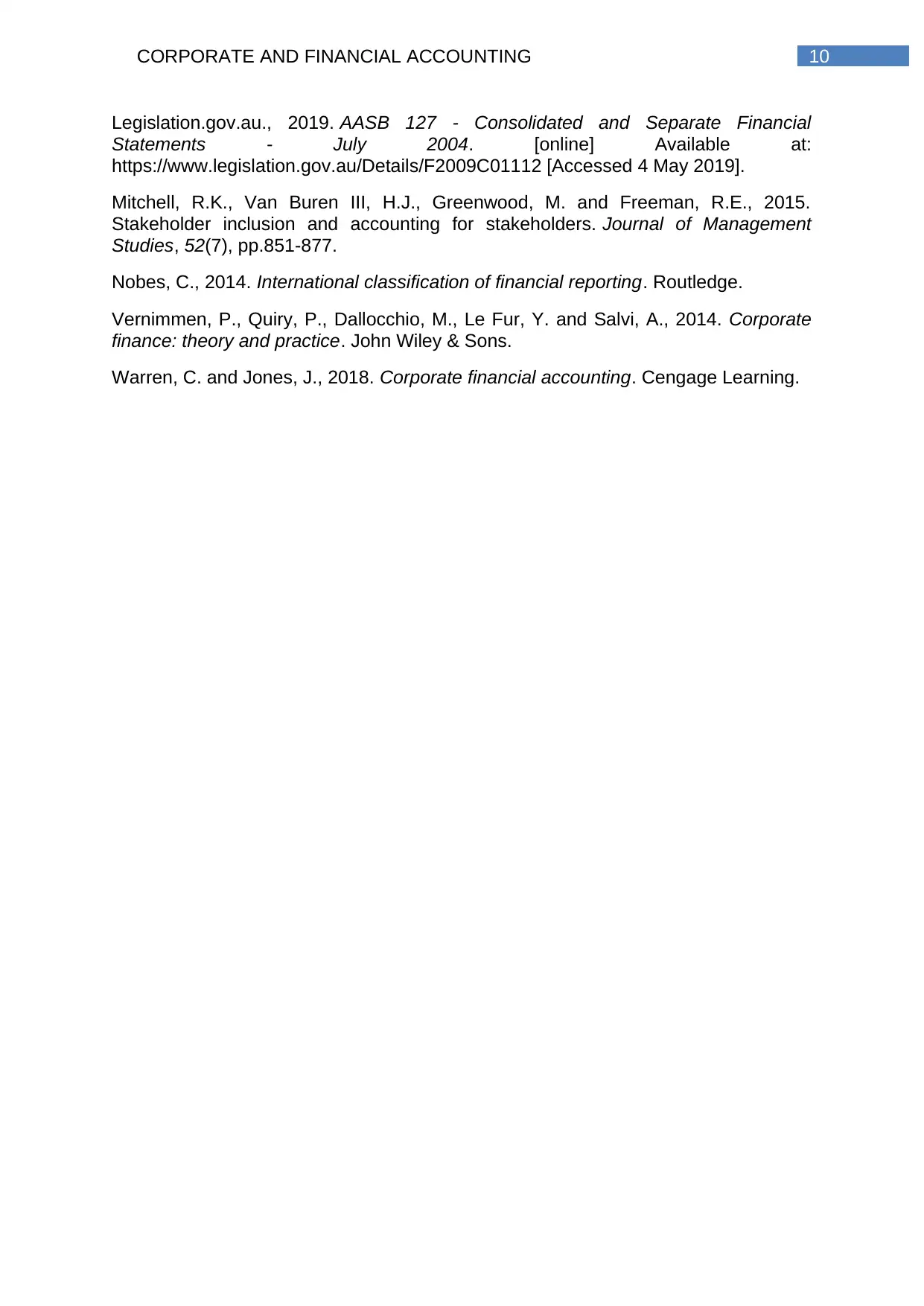
10CORPORATE AND FINANCIAL ACCOUNTING
Legislation.gov.au., 2019. AASB 127 - Consolidated and Separate Financial
Statements - July 2004. [online] Available at:
https://www.legislation.gov.au/Details/F2009C01112 [Accessed 4 May 2019].
Mitchell, R.K., Van Buren III, H.J., Greenwood, M. and Freeman, R.E., 2015.
Stakeholder inclusion and accounting for stakeholders. Journal of Management
Studies, 52(7), pp.851-877.
Nobes, C., 2014. International classification of financial reporting. Routledge.
Vernimmen, P., Quiry, P., Dallocchio, M., Le Fur, Y. and Salvi, A., 2014. Corporate
finance: theory and practice. John Wiley & Sons.
Warren, C. and Jones, J., 2018. Corporate financial accounting. Cengage Learning.
Legislation.gov.au., 2019. AASB 127 - Consolidated and Separate Financial
Statements - July 2004. [online] Available at:
https://www.legislation.gov.au/Details/F2009C01112 [Accessed 4 May 2019].
Mitchell, R.K., Van Buren III, H.J., Greenwood, M. and Freeman, R.E., 2015.
Stakeholder inclusion and accounting for stakeholders. Journal of Management
Studies, 52(7), pp.851-877.
Nobes, C., 2014. International classification of financial reporting. Routledge.
Vernimmen, P., Quiry, P., Dallocchio, M., Le Fur, Y. and Salvi, A., 2014. Corporate
finance: theory and practice. John Wiley & Sons.
Warren, C. and Jones, J., 2018. Corporate financial accounting. Cengage Learning.
1 out of 11
Related Documents
Your All-in-One AI-Powered Toolkit for Academic Success.
+13062052269
info@desklib.com
Available 24*7 on WhatsApp / Email
![[object Object]](/_next/static/media/star-bottom.7253800d.svg)
Unlock your academic potential
© 2024 | Zucol Services PVT LTD | All rights reserved.




